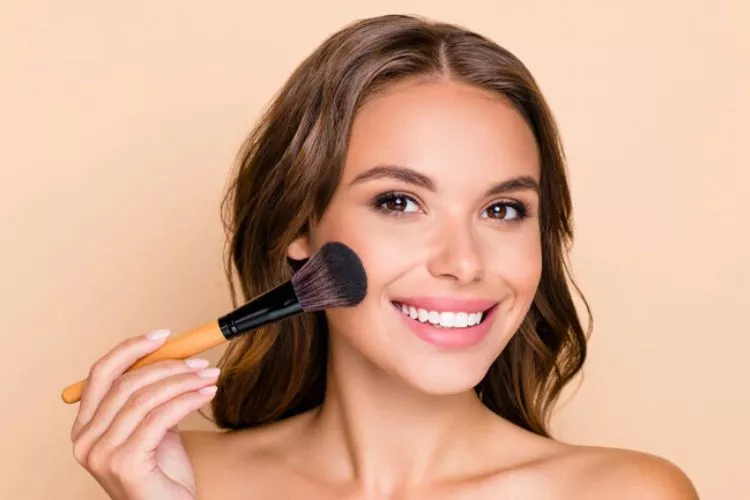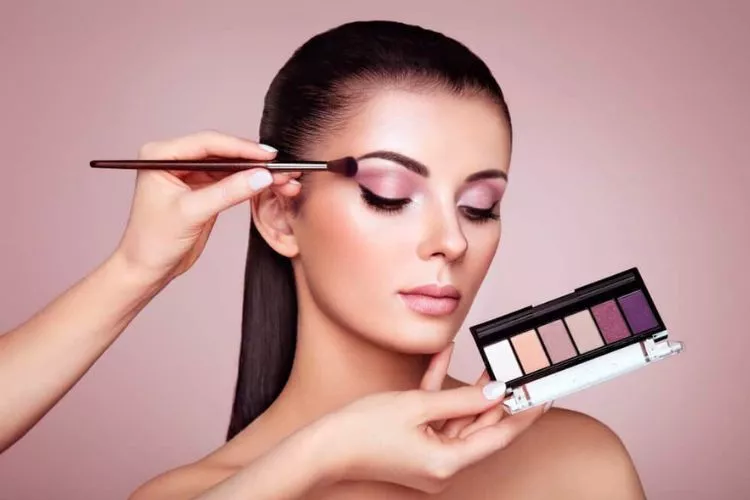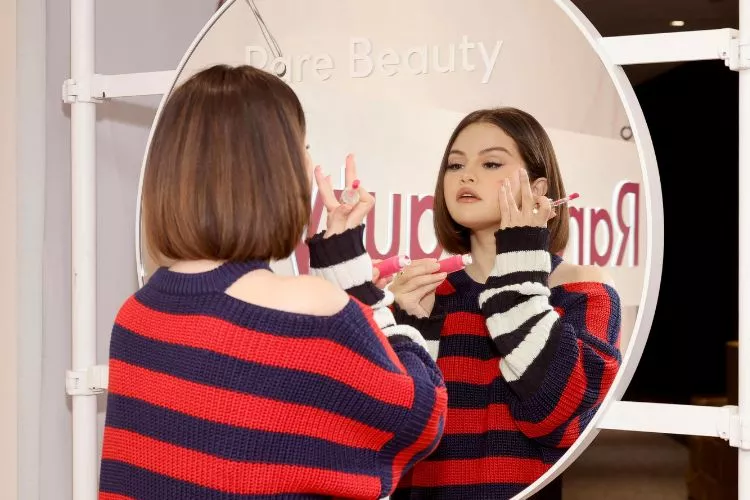From time to time, we all like to experiment and try new things, especially when it comes to our cosmetics collection.
One question that’s been making waves in the beauty world recently is: can you use eyeshadow as blush?

In this article, we’ll explore this intriguing query, weighing the pros and cons and diving into expert insights to arm you with all the information you need to make your makeup work beyond its intended purposes.
So, whether you’re in a pinch or just looking to shake up your routine, read on to find out more!
Can you use eyeshadow as blush?
Yes, you can use eyeshadow as a blush! The textures of most eyeshadows and blushes are similar, often finely milled powders. However, there are key considerations to keep in mind.
- Color: Ensure the eyeshadow color suits your complexion as a blush. Neutrals, pinks, peaches, and certain shades of purple usually work well.
- Pigmentation: Remember, eyeshadows are typically more pigmented than blushes, so apply lightly and build slowly.
- Blending: Fine blending is crucial to create a smooth, natural-looking flush.
- Ingredients: Check the product’s ingredients to ensure it’s safe and non-irritating for your skin.
So, while not created for this purpose, eyeshadows can be a versatile tool in your makeup bag. However, it’s always good to invest in a dedicated blush designed specifically for cheeks to achieve the best results.
Is it safe to use eyeshadow on face?
The answer is generally yes; most eyeshadows can be safely used on other parts of your face. However, it’s essential to note these points of caution:

- Ingredients: While they’re all meant for skin application, certain eyeshadows may contain pigments and additives not typically found in products formulated for facial use. Always check for potential irritants, allergens, or comedogenic substances, especially if you have sensitive skin.
- Suitability: The shades for eyeshadows are often designed specifically for the eyes, so using them elsewhere on the face might not achieve the anticipated result.
- Application: A little goes a long way regarding eyeshadows, given their heavy pigmentation. A gradual application is recommended, especially for dramatic or bright eyeshadows.
- Safety Measures: Always do a patch test even if the eyeshadow ingredients seem safe. Apply a small amount to your wrist or jawline to see any reaction before applying it to your face.
As a general rule, while eyeshadows offer the possibility of creative uses, products designed specifically for each area of your face are always the safest option.
What is a good substitute for blush?
In moments when you’ve run out of your favorite blush or simply want to try something new, here are several potential substitutes:

- Lipstick: This common beauty staple can double as a cream blush. Choose a shade that suits your skin tone and tap it lightly onto your cheeks, blending it with your fingertips for a fresh, dewy look.
- Eyeshadow: As discussed, some eyeshadows can make good blush substitutes. Opt for shades within the pink, coral, or warm brown family for the most natural-looking results.
- Bronzer: Bronzer can also work as a blush substitute, adding a warm, sun-kissed glow to your cheeks and contouring effect.
- Lip and Cheek Tints: These are versatile products for lip and cheek applications. They are usually sheer and buildable, allowing you to control the color intensity.
- DIY Beetroot Blush: Create a homemade blush with beetroot powder. Since it’s a natural product, it’s great for sensitive skin.
- Tinted Moisturizers or BB Creams: A dabble of tinted moisturizer or BB cream on your cheeks can create a subtle rosy effect if they’re a bit darker or rosier than your skin tone.
Remember that blending is key to achieving a natural look, no matter what substitute you use. Always test the product on a small part of your skin first to check for any adverse reactions.
frequently asked questions (FAQs)
u003cstrongu003eCan I use red eyeshadow as blush?u003c/strongu003e
Yes, you can use red eyeshadow as blush, although care should be taken due to the vibrant and highly pigmented nature of red eyeshadows. Start with a minimal amount on your brush, tap off any excess, and apply to your cheeks, blending carefully to create a natural-looking flush. It’s advised to use matte or satin eyeshadows rather than sparkly or glittery ones to replicate the texture of a typical blush.
u003cstrongu003eCan you use pink eye shadow as blush?u003c/strongu003e
Pink eyeshadows can work wonderfully as blush. Ensure the pink shade complements your skin tone, and opt for a matte or satin finish. Remember, eyeshadows are more pigmented than blushes, so apply the product lightly and gradually increase the intensity. Good blending is vital to achieve a smooth finish that mimics the look of a standard blush.
u003cstrongu003eCan I use lipstick or eyeshadow for blush?u003c/strongu003e
Yes, you can use either lipstick or eyeshadow as a blush substitute. For lipstick, choose a shade that suits your skin tone and lightly dab it onto your cheeks before blending with your fingertips. Pick a compatible color like pinks, corals, or warm browns for eyeshadow, ideally with a matte or satin finish. Apply cautiously, build the intensity, and blend well for a blush-like appearance.
Tips for Using Eyeshadow as Blush
While it’s easy to assume that any eyeshadow can double as a blush, there are a few extra tips to ensure you get the best results when repurposing your eyeshadow.
1. Choose the Right Finish
Eyeshadows come in various finishes, and while shimmer and glitter may work well for eyes, they can make your cheeks look overly sparkly.
To mimic the effect of a traditional blush, stick with matte or satin finishes. These provide a soft, natural flush that won’t look too dramatic on your cheeks.
2. Use the Right Tools
A fluffy blush brush is your best friend when applying eyeshadow as blush. Avoid using dense eyeshadow brushes, as they will apply too much product at once.
Instead, use a light hand with a brush that will allow you to build the color gradually. A beauty sponge can also be helpful for blending and diffusing any harsh lines after application.
3. Blend, Blend, Blend
Blending is crucial to avoid a patchy or overly intense application. When using eyeshadow as blush, start from the apples of your cheeks and blend upward toward your temples for a lifted, youthful appearance. Make sure to blend the product into your skin for a seamless finish.
4. Layering with Other Products
For added dimension, consider layering your eyeshadow blush with a bit of highlighter or bronzer. This will give your cheeks more depth and a glowing effect, which is ideal for creating a natural, radiant look. Just be careful not to overdo it—less is more when it comes to layering!
5. Consider the Season
If you’re experimenting with eyeshadow as blush, think about the seasons and how different colors can match your mood or the time of year.
In warmer months, you might want to go for peachy or coral shades, while deeper pinks or mauves can add a lovely flush during the colder months.
Conclusion :
The world of makeup is vast and filled with creative possibilities. As we’ve learned, you can use eyeshadow as blush, and even lipstick can make a suitable alternative.
However, always be mindful of ingredients, pigmentation, and proper blending techniques to ensure safety and achieve optimal results.
While experimenting can be fun and resourceful, investing in dedicated blush products will ensure the best outcome for your complexion.
So, let your creativity shine, all while knowing when to reach for your trusted blush.
